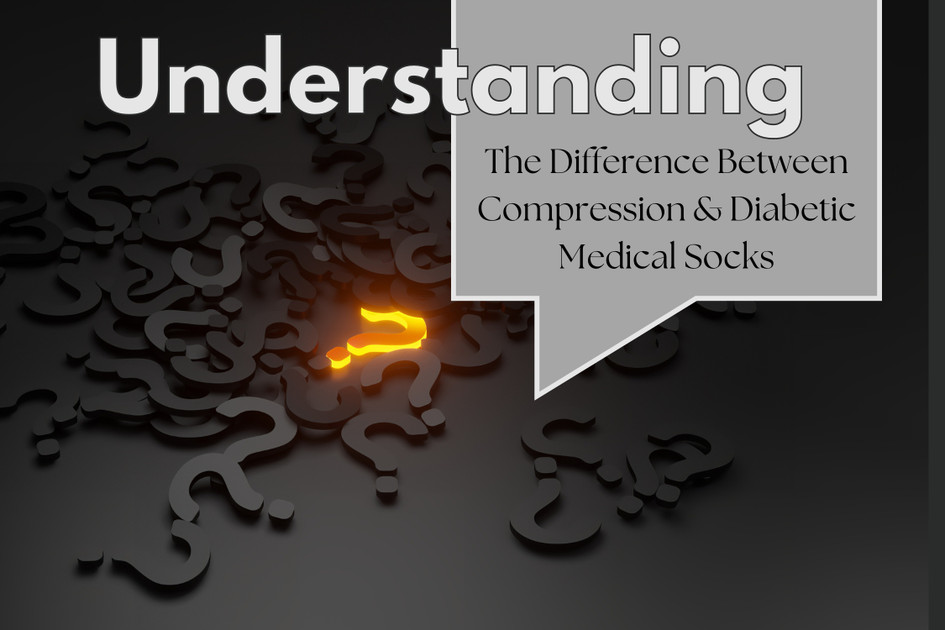Understanding the Differences Between Medical Socks and Choosing the Right Type for Your Patients
Posted by Sockswholesale team on Sep 13th 2024
Medical socks are a critical component in managing various health conditions, especially for patients with circulation issues or diabetes. For B2B buyers in pharmacies and medical supply facilities, it's important to understand the differences between the types of medical socks, such as compression socks and diabetic socks, to ensure that your inventory meets the specific needs of your customers. This article explores these differences, provides guidance on selecting the right type, and incorporates recommendations from leading health organizations.

1. Compression Socks vs. Diabetic Socks: Key Differences
Compression Socks:
- Purpose: Compression socks are designed to apply graduated pressure to the legs, which helps improve blood flow back to the heart. They are typically used to manage and prevent conditions related to poor circulation, such as varicose veins, deep vein thrombosis (DVT), and edema.
- Pressure Levels: Compression socks are available in various pressure levels, typically ranging from mild or sport grade (8-15 mmHg) to extra firm or post surgical grade (30-40 mmHg). The pressure is highest at the ankle and gradually decreases up the leg, aiding in blood circulation.
- Material and Design: Made from elastic materials, compression socks provide firm support and are commonly available in knee-high or thigh-high lengths. According to the American Heart Association (AHA), compression therapy is essential for helping manage conditions like Deep Vein Thrombosis (DVT) and chronic venous insufficiency by keeping the blood pushed back toward the heart and helping prevent clots in the feet and legs.
Diabetic Socks
- Purpose: Diabetic socks are specifically designed to minimize the risk of foot injuries and enhance comfort for individuals with diabetes. They help prevent complications such as ulcers, blisters, and infections, which can arise from minor foot injuries in diabetic patients.
- Pressure and Fit: Unlike compression socks, diabetic socks are non-binding and offer minimal to no compression. This is crucial for avoiding restricted blood flow, which is particularly important for diabetic patients who may already have compromised circulation.
- Material and Design: These socks are usually made from soft, moisture-wicking materials to keep feet dry and reduce the risk of infections. They also feature seamless construction to prevent irritation and additional cushioning to protect sensitive areas. The American Diabetes Association (ADA) emphasizes the importance of using non-restrictive socks to prevent foot ulcers in diabetic patients by preventing restrictions to circulation and allowing blood to flow more readily to the end of the extremeties.
2. When to Recommend Compression Socks vs. Diabetic Socks
When to Recommend Compression Socks:
- Patients with Circulatory Issues: Compression socks are ideal for patients with conditions like varicose veins, DVT, or chronic venous insufficiency. These socks help improve blood flow and reduce swelling, making them essential for managing these conditions.
- Post-Surgical Recovery: Compression socks are often recommended after surgery to prevent blood clots and promote faster recovery. The National Institutes of Health (NIH) advises the use of compression socks post-surgery to enhance circulation and prevent complications like DVT.
- Immobilized Patients: For patients on long flights, extended bed rest, or those with limited mobility, compression socks can help reduce the risk of DVT and other circulatory problems.
When to Recommend Diabetic Socks:
- Patients with Diabetes: Diabetic socks are crucial for individuals with diabetes, particularly those at risk for foot injuries from poor or restricted circulation or who have reduced sensation in their feet due to neuropathy. These socks help prevent ulcers and blisters by providing a non-restrictive fit and reducing friction, as recommended by the American Diabetes Association (ADA).
- Patients with Sensitive or Swollen Feet: Diabetic socks offer gentle support without constriction, making them ideal for maintaining foot health in patients with sensitive or swollen feet.
3. Determining the Right Fit for Each Patient
Assessing Circulatory Needs:
- For patients who require support to improve blood flow due to a circulatory condition, compression socks are the appropriate choice. The level of compression should be selected based on the severity of the condition—mild compression for minor swelling and higher levels for serious issues like DVT.
Evaluating Diabetic Risks:
- For diabetic patients, the primary goal is to protect the feet from injury while maintaining healthy circulation. Diabetic socks are best suited for these individuals, especially if they have a history of foot ulcers or neuropathy.
Considering Mobility and Daily Activities:
- For active patients or those who are frequently on their feet, padded or cushion socks may also be beneficial to provide additional comfort and support. However, the choice between compression and diabetic socks should be based on their specific health needs.
Conclusion
Choosing the right type of medical socks for your patients is crucial to ensuring their health and comfort. Compression socks are best for individuals who need enhanced blood circulation, particularly those with varicose veins, DVT, or post-surgical recovery needs. Diabetic socks, on the other hand, are designed for those with diabetes, offering protection and comfort without restricting blood flow. By understanding these differences and carefully assessing your patients' needs, you can ensure they receive the most appropriate care.
This understanding will help buyers in pharmacies and medical supply facilities stock the right products, ultimately enhancing patient care and outcomes.
References
- American Diabetes Association (ADA). "Foot Care Guidelines." ADA, https://www.diabetes.org.
- National Institutes of Health (NIH). "Compression Stockings for Post-Surgical Recovery." NIH, https://www.nih.gov.
- American Heart Association (AHA). "Compression Therapy for Venous Insufficiency and DVT." AHA, https://www.heart.org.
- Wound Healing Society (WHS). "Guidelines for the Use of Compression and Diabetic Socks." WHS, https://woundheal.org.

